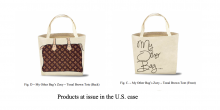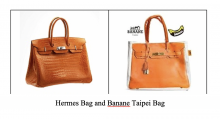A “parody” is a simple form of entertainment conveyed by adapting a well-known trade mark or work in a way of satire, ridicule, teasing or criticism. In Taiwan, there is no relevant law in the current Trademark Act, Copyright Act or Fair Trade Act that expressly stipulates for the relevant infringement issues, leading to different court’s opinions in practice. This blog aims to introduce the opinions of the Taiwan Intellectual Property Court (IP Court) in notable cases and to provide strategic advice to brand owners.
CASE 1: CHANEL’S “DOUBLE C DEVICE” TRADE MARK INFRINGEMENT CASE
Case facts:
Since January 2012, XIANG JUN INTERNATIONAL E-COMMERCE LTD. had been purchasing products labelled with a counterfeit trade mark from a Chinese factory and listing them from their company with the purpose of selling them for profit.

The court determined that since the defendant had labelled the products with the defendant’s own trade mark, there was no intent of trade mark infringement. Consequently, as the defendant claimed that the counterfeit trade mark was a pattern “decorated in a humorous manner”, and that it was not a counterfeit trade mark of Chanel, the court did not examine further on this matter.
Opinion of the District Court in Taiwan Shilin District Court 2014 Zhiyizi No. 3 Decision
Opinion of the IP Court in Taiwan Intellectual Property Court 2014 Xingzhishangyi No. 63 Decision
The IP Court (Court of Appeal) overturned the ruling of the District Court for the reasons below:
- The defendant made use of a trade mark that is likely to cause confusion, and is found to have mens rea (a guilty mind)
The defendant had labelled the products with their own registered trade mark. However, based on the common concept of trade in society, it is not uncommon that stores may sell products of multiple brands at the same time. Moreover, the counterfeit trade mark is at the front of the product, with a highly similar concept of design to the Chanel registered trade mark, which is very likely to cause confusion to the relevant consumers. The defendant is considered to have made use of the trade mark, and is found to have mens rea (a guilty mind).
- The Court held that a parody should convey a message that is contradictory to the original work
The defendant claimed that the counterfeit trade mark was a design of parody, and that it was not a use of trade mark. However, the court found that a “parody of a trademark” can be allowed only if the imitating trade mark contains the entertainment value of humour, satire or criticism, and conveys a message of contradiction. Moreover, both “the public interest of avoiding confusion” and “the public interest of freedom of expression” should be taken into account. The pattern of counterfeit trade mark in this case was not found to convey an opposite image or any contradictory messages compared to the Chanel trade mark. It is hard to consider that the pattern is an expressive work, as it does not contribute to a significant amount of cultural or social values that it is necessary to sacrifice the protection of trade mark rights. The defendant was found to be free-riding, and the behaviour constituted trade mark infringement.
CASE 2: LOUIS VUITTON MALLETIER v. LG HOUSEHOLD & HEALTH CARE (TAIWAN), LTD.
Case Fact:
LG HOUSEHOLD & HEALTH CARE (TAIWAN), LTD (“LG”) had been placing patterns and trade marks that are highly similar to the Monogram Multicolor pattern and registered trade marks of LOUIS VUITTON MALLETIER (“LV”) on their products since October 2016, infringing on LV’s trademark rights.

LV’s Trademark and Design Pattern

LG’s products
Opinion of the District Court in Taiwan Intellectual Property Court 2018 Minshangsuzi No. 1 Decision
- In reference to the practice in the US, LG’s products are considered as parody
Although there is high similarity between the patterns used by the products at issue and LV’s trademark, the court held that the protection of parody should be applied for the reasons below:
- In reference to the judgment of the “My Other Bag” case in the US (Louis Vuitton Malletier, S.A. v. My Other Bag, Inc., 16-241-cv (2nd Cir., Dec. 22, 2016)), although Taiwan consumers may not necessarily understand the classic American joke “My Other Car…”, the text “My Other Bag” is plain and simple, and the consumers should be able to understand the point of the joke.

Products at issue in the U.S. case
- The text on the products at issue had been replaced with “MOB” instead of the original “LV,” and the text “My Other Bag × THE FACE SHOP” under the pattern indicated it is a co-branded product, presenting a more day-to-day style rather than LV’s boutique fashion. This demonstrates the public interest of freedom of expression in art.
- Although the trade marks and products of the two parties are similar, both brands have already established their reputation and are known to the relevant consumers in the Taiwanese market, and no likelihood of confusion or undermining of the LV’s trade mark distinctiveness had occurred. Moreover, based on the fact that the US court did not rule it as an infringement, the defendant was not found to have malicious intent when using the trade mark while selling products in Taiwan.
Opinion of the IP Court: Taiwan Intellectual Property Court 2019 Minshangshangzi No. 5 Decision
The IP Court (Court of Appeal) overturned the ruling of the District Court for the reasons below:
- The court determined that LG’s victory in the Supreme Court case of the United States shall not be adopted:
The pattern on the products at issue was different from the pattern used by My Other Bag (MOB) in the US case. The products and the specimen of use of such products also differed. The judgement in the US case cannot in turn be directly invoked as a reference in this case to determine whether an infringement is constituted in the Taiwan case.
- The court held that the products at issue did not constitute parody and fair use:
- The text “My Other Bag” on the products at issue originates from a classic American joke, “My Other Car”. However, the products at issue were cushion compact foundations, handheld mirrors and small canvas bags, which were small products. These products could not be referred to as “Bags”, and their properties were totally different from the alluded LV handbags. Moreover, this case was different from the US case, in which a MOB’s big canvas tote bag was in allusion to a LV handbag. Taiwanese consumers, having a different cultural background from the US consumers, were not likely to find this joke to be funny.
- The pattern of the trade mark was highly similar to the trade marks at issue, and it took up over two thirds of the entire area on the product at issue. Although the text “My Other Bag x THE FACE SHOP” was shown on the product, the words were small and written in cursive. As a result, the pattern at issue was still the focal point that attracted consumers’ attention. Moreover, LV’s trade marks were much more well-known than “My Other Bag” or “THE FACE SHOP.” The pattern at issue thus gave the impression of a stronger distinctiveness to consumers than the text “My Other Bag x THE FACE SHOP.”
- The defendant specifically emphasised “the ‘luxury brand’ cushion compact foundation that is most worthy of collection” in the advertisement, which shows an intention to confuse consumers and to free-ride on the fame of LV.
A possible case of parody in Taiwan: trademark infringement dispute between Hermes and Banane Taipei
There were only 2 Taiwan IP Court and Supreme Court cases on the issue of the parody product constitutes trademark infringement, which have been covered by our article, and are all in favour of the brand owners.
In fact, there was a similar case back in 2013, which is known as “Banane Taipei Bag” case. The luxury goods brand “Hermes” filed a lawsuit at the Taiwan IP Court against a Taiwanese handbag manufacturer, Banana International, for infringing Hermes’s trademark rights. At the end, the Court ruled in favour of Hermes.

Hermes Bag and Banane Taipei Bag
Although practitioners are of the opinion that this infringement case may be related to parody, the court did not further investigate or discuss whether the “Banane Taipei Bag” constitutes a trademark parody.
Suggested strategies
The issue of parody originates in the US, and there are currently no laws stipulating such related issues in Taiwan. In the first case introduced in this article (Chanel’s “DOUBLE C DEVICE” trade mark infringement case), the court of appeal pointed out that parody is allowed only when it “conveys a message of contradiction”. The court held that the trade mark at issue did not convey an image of contradiction, and was merely free-riding on Chanel’s commercial repute, thus constituting trade mark infringement.
In the second case LOUIS VUITTON MALLETIER v. LG HOUSEHOLD & HEALTH CARE (TAIWAN), LTD., although the principle of adjudication adopted by the court is mostly the same as that of the US court, the Taiwan IP Court highlighted the fact that the American joke simply could not achieve the same humorous and mocking effect for Taiwanese consumers as it does for American consumers. It therefore does not constitute a parody. Furthermore, in view of the defendant’s actual use of the trade mark, the advertising slogans such as “luxury brand” and “classic fashion” show the intent of free-riding on LV’s commercial repute. It therefore does not constitute fair use.
In light of the adjudicating principles demonstrated in the two cases above, brand owners should keep in mind when enforcing rights that the Taiwan IP Court tends to protect the trade mark owners in determining infringement in cases of parody.
How FICPI makes IP attorneys more effective
Membership of FICPI helps organisations protect and build value in their IP assets; insights from members worldwide help to ensure that independent IP attorneys have access to a rich source of knowledge through FICPI’s news, blogs, events and LinkedIn presence. The FICPI member directory is an invaluable resource for making introductions and connections with IP experts around the world.
Next steps
- Find out more about FICPI’s Study & Work Committee focusing on Trade Marks (CET 1)
- Find out more about FICPI’s Study & Work Committee focusing on Asian Issues (CET 8)
